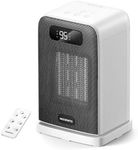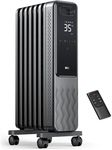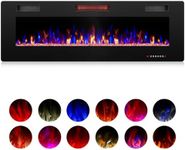Buying Guide for the Best Oil Heaters
Choosing the right oil heater can make a big difference in how comfortable and energy-efficient your space feels during colder months. Oil heaters are popular for their quiet operation, steady heat, and safety features. When shopping for an oil heater, it's important to consider the size of the room you want to heat, how quickly you want it to warm up, and any extra features that might make your experience more convenient. Understanding the key specifications will help you find a heater that matches your needs and keeps you cozy all winter long.Heating Power (Wattage)Heating power, usually measured in watts, tells you how much heat the oil heater can produce. This is important because it determines how large a space the heater can effectively warm. Lower wattage heaters (around 600-1000W) are best for small rooms or personal spaces, while medium wattage (1000-1500W) suits average bedrooms or offices. High wattage heaters (over 1500W) are designed for larger living rooms or open areas. To pick the right wattage, consider the size of your room: a small heater in a big room won't keep you warm, while a large heater in a small room may be overkill and use more energy than needed.
Number of FinsThe number of fins refers to the metal columns on the heater that radiate heat. More fins generally mean a larger surface area, which can help distribute heat more evenly and efficiently. Heaters with fewer fins are more compact and heat up quickly, making them suitable for smaller spaces or for moving between rooms. Models with more fins are better for larger rooms or for maintaining warmth over longer periods. Think about your space and whether you need quick, focused heat or steady, widespread warmth.
Thermostat and Heat SettingsA thermostat lets you set and maintain your desired room temperature, while multiple heat settings allow you to adjust the heater's output. This is important for comfort and energy savings, as you can avoid overheating the room or wasting electricity. Some heaters have simple dial controls, while others offer digital thermostats for more precise adjustments. If you want to set it and forget it, look for a model with an accurate thermostat and several heat levels to match your comfort needs.
Timer FunctionA timer allows you to program the heater to turn on or off at specific times. This feature is useful for pre-warming a room before you wake up or come home, and for ensuring the heater doesn't run all night or when you're not around. Timers can range from simple mechanical dials to digital programmable options. If you have a regular schedule or want to save energy, a timer can add convenience and peace of mind.
Portability FeaturesPortability features include wheels, handles, and the overall weight of the heater. These are important if you plan to move the heater between rooms or store it away when not in use. Lightweight models with sturdy wheels and easy-grip handles are best for frequent moving, while heavier models may be better for stationary use. Consider how often you'll need to relocate the heater and choose a design that matches your lifestyle.
Safety FeaturesSafety features such as overheat protection, tip-over switches, and cool-touch exteriors are crucial for preventing accidents, especially in homes with children or pets. Overheat protection automatically shuts off the heater if it gets too hot, while tip-over switches turn it off if it falls over. Cool-touch surfaces prevent burns if someone touches the heater. If safety is a top concern, look for models with multiple built-in protections.
















